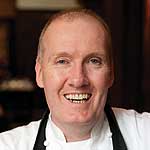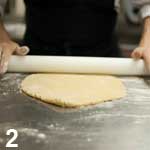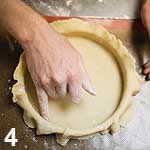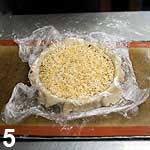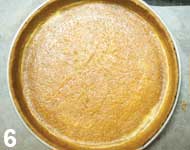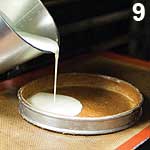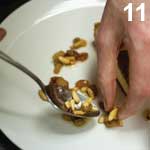Masterclass: custard tart with Anthony Demetre
The custard tart has undergone decades of refinement since it first appeared on fine-dining menus. Chef Anthony Demetre, of the Michelin-starred London restaurants Arbutus and Wild Honey, shows Michael Raffael how to get it right every time.
Custard is a peculiarly English word. It's more than 600 years old. The earliest "custard" recipes were like quiches: pastry base, meat or fish and then egg topping. These tarts or pies survived almost unchanged for hundreds of years, some with the addition of dried fruit, other flavoured with spices such as nutmeg.
"Custard pies" didn't come on the scene until Victorian times. Then, baked egg custard, without any pastry, became a favourite dessert. More of a junket texture, it contained whole eggs, sugar and milk, sometimes with cream, and was baked in a bain-marie. Nutmeg was the popular flavouring, but peach leaf and lemon zest were common, too.
Anthony Demetre believes that the custard tart - as restaurants prepare it now - probably originated with Gary Rhodes, either when he was at the Castle, Taunton, during the 1980s or when he moved to the Greenhouse.
In texture it's rich like the lemon tarts that have become a standard. The custard base uses egg yolks only, where past cooks used whole eggs. Whipping cream has replaced milk. That said, there's still room for variety. Demetre's version relies on the minimum amount of egg (nine yolks to one litre of cream) to set the filling. This gives a delicate texture.
When Phil Vickery replaced Rhodes at the Castle he made his custard tart with more yolks - 12 to one litre of cream - to give a texture closer to a crème brûlée.
A generation ago, the late Jane Grigson wrote that northerners seemed to like soggy pastry for their custard tarts. The current generation of chefs work with an almost brittle textured crust that remains short and melting. Any hint of softness in it would spoil the impact. To achieve this, the tart has to be served spanking fresh, not as a left-over from the day before.
ANTHONY DEMETRE
If there was such a thing, Anthony Demetre would belong to the school of British chefs who reacted against the nouvelle cuisine fad that threatened to engulf posh restaurants in the 1980s. Then he worked alongside Gary Rhodes at the Castle hotel, Taunton, for the princely sum of £8,000 per year. His two head chefs at Wild Honey in London's West End both earn many times that and have a share in the business.
His passion for cooking that is neither too fiddly nor too expensive has brought him success, stars for his two London restaurants, Arbutus and Wild Honey, and Square Meal's 2010 Restaurant of the Year title.
His formative years, though, had another side to them. He worked for six years with Bruno Loubet, first at the Four Seasons and then at L'Odeon. He also did a stint with Pierre Koffmann, who seems, he says, to appreciate his cooking: "He was eating in Arbutus twice last week."
Recent reviews, he points out, have criticised overcomplicated cooking that seeks to justify inflated prices. He describes such snobbish cuisine as "passé". The French is no accident: not only is his wife French but his next venture, a classic French bistro, is due to open in Covent Garden in the autumn.
CUSTARD TART
PLANNING
Freshness is critical. Wild Honey makes a batch that's big enough for two tarts. It bakes one at lunch, the other for evening service. Prepared this way the pastry stays crisp and the custard delicate, almost quivering.
SUGAR PASTRY
Prepare this in a cool environment or it will be too difficult to handle. Make about 700g for 2 x 20cm flan rings.
INGREDIENTS
â- 25g cornflour
â- 150g caster sugar
â- 200g butter
â- 2g salt
â- 1 medium-large egg (about 65g)
â- Extra flour for rolling
PASTRY DOUGH
Start the pastry dough in the machine with a K-beater attachment. Finish it by hand.
Put the dry ingredients in a mixing bowl. At a slow speed mix them to a coarse crumb (1). There should still be flakes of fat visible in the mixture.
Add the egg and continue mixing until the pastry starts to come together. Turn it out on to a work surface and work it by hand until it forms a smooth dough. Divide into two pieces and rest until needed.
ROLLING
Sprinkle flour on the work surface. Place the slightly flattened dough on it. Roll out.
When rolling, don't:
â- Press down hard on the pastry.
â- Try to squeeze it out.
â- Push the pin over the edges.
â- Turn the pastry over when rolling.
Do:
â- Turn the dough after each roll. This helps keep the pastry an even shape and thickness.
â- Work quickly. The pastry contains a lot of fat and can become sticky.
Roll out to a rough circle - about 30cm diameter and 3mm thick - for a 20cm tart ring(2).
Note For this pastry, which is very short and which is going to be baked blind, it isn't necessary to prick the paste with a pastry docker.
HOW MUCH PASTRY FOR THE JOB?
Think in terms of a circle of paste rather than the diameter of the hoop, because you have to allow for the sides of the ring and some trim.
The thickness of the pastry will also vary: less for a small, individual tartlet; more for a larger tart. Professional pastry makers may be able to reduce these figures a little.
| - Circle | Pastry Weight | - Thickness |
| - 12cm | 70g | 2mm |
| - 14cm | 100g | 2mm |
| - 16cm | 120g | 2mm |
| - 18cm | 150g | 2.5mm |
| - 20cm | 200g | 2.5mm |
| - 22cm | 250g | 3mm |
| - 25cm | 300g | 3mm |
| - 28cm | 350g | 3mm |
| - 30cm | 400g | 3mm |
| - 32cm | 450g | 3mm |
| - 35cm | 500g | 3.5mm |
LINING THE TART RING AND BAKING BLIND
Put a Silpat mat on a heavy-gauge baking sheet or line it with baking parchment. Put a 20cm lightly greased tart ring on it. Preheat the oven to 170°C for a convection oven, 10 degrees higher for a standard one.
Lift the pastry on to the rolling pin and lay it in the ring(3). Press it into the edges with fingers lightly dusted in flour. Allow any excess pastry to hang over the edges (4).
Line the pastry with either clingfilm or baking parchment. Fill the ring with rice, baking beans, ceramic beads or similar, to stop the base from ballooning (5).
Bake 20 minutes and remove the film with the beans. Finish baking until the pastry is an even, rich, biscuity brown (6).
DON'T WASTE THE TRIMMINGS
When the pastry ring has baked, the trimmings are shaved off to give it an even finish. When blended to a coarse powder, these can be added to ice-creams or, at Wild Honey, to a Paris Brest instead of the classic praline mixture.
CUSTARD FILLING
Makes about 1,300ml, enough for 2 x 20cm tarts.
INGREDIENTS â- 9 eggs, about 65g each
â- 150g caster sugar
â- 1 litre UHT whipping cream (35% fat)
METHOD
Separate the eggs and only use the yolks for this (7). The whites can be turned into meringues, floating islands, etc.
Whisk the yolks and sugar until the mixture whitens. Whisk in the cream until the mixture is thoroughly blended. Leave it to stand until the froth dies down (8). Keep chilled until ready for use.
BAKING
INGREDIENTS
â- 1 baked tart ring
â- Egg wash (less than one beaten egg)
â- ½ the custard filling mixture
â- 1 nutmeg
METHOD
Set the oven to 100°C. The baked pastry shell is still in its protective ring and standing on the prepared baking sheet.
Brush the inside of the pastry shell with a little egg wash. Leave it to set. This will stop the custard filling soaking into the pastry.
Put the baking sheet in the oven before filling the pastry to catch any spillage. Fill the pastry with the custard (9) and bake until just set, about 50 minutes, perhaps longer depending on the oven.
Take the custard out of the oven. While it is still hot grate a layer of nutmeg over the surface. Use a little less than one whole nutmeg (not powdered nutmeg) (10).
Cool, but don't transfer to the fridge. The tart should remain at ambient temperature.
SERVING
Use one 20cm custard tart for 8 portions.
Remove the tart ring. Dip a sharp, thin-bladed knife into boiling water. Wipe it. While it is still hot cut slices of the custard tart.
Accompany with about 1tbs of sultana and pine kernel syrup (see below) (11).
SULTANA AND PINE KERNEL SYRUP
For about 16 portions. Lightly toast 50g pine kernels without colouring. Pour boiling water over 100g golden sultanas. Let them swell and then drain. Prepare beurre noisette with 200g unsalted butter - stir it in a frying pan over a medium heat until the solids brown. Combine these ingredients with about 50ml stock syrup.
THE BOTTOM LINE
Anthony Demetre aims for an overall 28% food cost at Wild Honey. wo custard tarts - 16 portions - cost about £8.50 (50p per portion). It sells for £6.95 (including VAT) on the Á la carte or may be part of an £18.95 lunch menu. Any portions left from lunch may figure on the "Sweet and Savoury" menu served in the afternoons. Egg whites that aren't used are made into a floating islands dessert. Baked pastry trimmings are added to a praline mixture.



